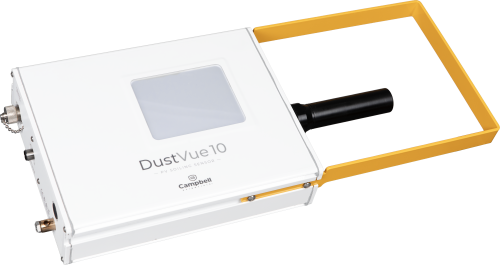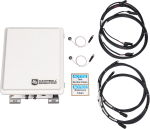
with collocated PV cells






Überblick
The DustVue™10 takes the most trusted method of comparing two solar panels for soiling loss measurements and puts it in one small, easy-to-install sensor package. The reference sensor requires very little cleaning. Even better, no water is needed to clean the panel.
Lesen Sie mehrFunktionen und Vorteile
- Highly accurate soiling measurement (±1% uncertainty)
- Bifacial, separate soiling ratios for front and rear
- Maintenance-free design (patent pending)
- Compliant with IEC 61724-1
- Easy-to-install design to reduce deployment complexity
- Best spectral match with production modules
- Rugged reliability with industrial-grade surge protection
- Industry-standard Modbus RTU over RS-485
Bilder



3D/CAD-Dateien:
Technische Beschreibung
Understand your losses due to soiling.
Accurate PV Module Soiling Loss Measurement
Accumulated dust, snow, and contaminants significantly reduce photovoltaic (PV) power output, ranking as the second most critical factor after irradiance in solar plant performance losses. The DustVue 10:
- Provides the most accurate measurement of PV module soiling
- Requires minimal maintenance
- Incorporates a revolutionary and convenient design
Precision and Reliability in Soiling Measurement
The DustVue 10 accurately calculates soiling loss by comparing irradiance between the clean reference sensor and soiled detector. The clean reference sensor is kept clean within a dust-free housing that briefly opens at a cadence you select, and only when conditions are ideal to minimize reference sensor soiling. This reduces the need for reference sensor cleaning to semiannually, and the soiling reference sensor cleaning can coincide with the periodic cleaning of all your plant panels.
The DustVue 10 uses collocated PV cells to measure irradiance, minimizing spectral response differences with actual operational PV panels. Irradiance calculations follow IEC 60904 using short-circuit current and cell temperature.
Advanced Technology for Comprehensive Insights
Integrated sensors measure ground-reflected light, allowing precise calculation of rear-side soiling losses. The DustVue 10 uniquely measures front-side, rear-side, and cumulative soiling losses. This makes it an inexpensive choice for bifacial PV module installations.
Designed for Simplicity and Accuracy
The DustVue 10 is delivered field-ready, requiring no programming:
- Simple installation within minutes on the same racking as operational modules
- Intuitive configuration via web-based user interface accessible through USB-C
- Scheduled daily calculations of soiling-loss indices with built-in data filtering for accuracy and reliability
- Automated infield calibration between the clean and soiled cells
Exceptional Low-Maintenance Operation
- Anticipated semiannual, or less, maintenance schedule significantly reduces operational costs.
- No water or frequent intervention is needed.
Seamless SCADA Integration and Superior Support
The DustVue 10 supports direct SCADA integration with Modbus RTU over RS-485 and offers robust industrial Class 4 surge protection. Campbell Scientific's unmatched global customer support and trusted engineering legacy assure consistent performance and reliability.
Spezifikationen
| Operating Temperature Range | -40° to +70°C |
| Soiling Ratio Uncertainty | ±1% |
| Input Power | 12 to 32 Vdc |
| Power Consumption - Idle |
|
| Power Consumption - Active |
|
| Power Consumption - Active with Heater Full on | ~24 W |
| -NOTE- | A small heater prevents the cover gasket from freezing shut, which could interfere with measurements or damage the gasket. The heater can be active when the ambient temperature is below 5°C and when humidity and temperature conditions could cause frost. |
| Communications | Modbus RTU over RS-485 |
| IP Rating | IP65 |
| Shipping Dimensions | 27.94 x 58.42 x 11.43 cm (11 x 23 x 4.5 in.) |
| Shipping Weight | 3.54 kg (7.8 lb) |
Dokumente
Broschüren Produkte
Downloads
DustVue 10 Program Example v.1 (3 KB) 21-11-2025
Use this program as a template to create a program to read and write to the registers on a DustVue 10 sensor.

